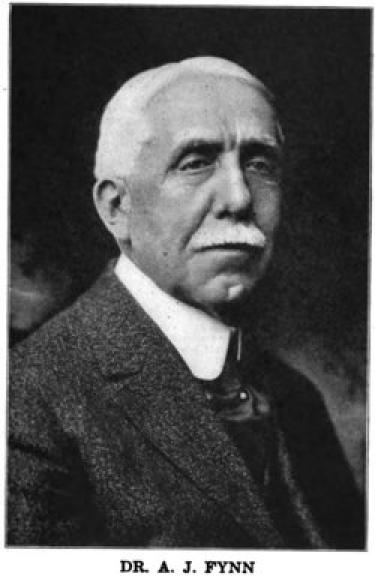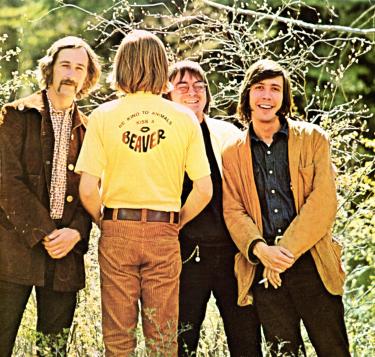Colorado’s State Songs Share a Message that Still Resonates Today
Did you know that Colorado has not one, but two state songs? “Where the Columbines Grow” became the first in 1915, while “Rocky Mountain High” was named the second in 2007. Both have been criticized—primarily due to their lyrics—but each has strengths that deserve a deeper look. Inspired by exceptional summertime experiences in the Rocky Mountains, their composers cared deeply about nature as well as the stunning beauty of Colorado. While both have been discussed widely, neither song has been recognized for its warnings about the environment.

Image of A.J. Fynn. W.F. Stone, History of Colorado, Vol. 4 (Chicago: Clarke, 1918-19), 277.
A. J. Fynn (1854-1930) was out for a mountain hike near Schinzel Flats when his group came upon a meadow filled with the beautiful state flower. The experience inspired the music and lyrics for “Where the Columbines Grow” in 1911. John Denver (1943-1997) saw the Perseid meteor shower when he was camping at Williams Lake near Aspen fifty years ago.1 The experience moved him to write the hit “Rocky Mountain High” with guitarist Mike Taylor (1948-2010) in 1972. Although composed over sixty years apart, these songs—and their creators—have more in common than you might expect.
A. J. Fynn was not primarily a musician. Born in Salisbury, New York, he moved to Colorado in 1889 to teach at Central City. He remained an educator, but also explored archaeology in his new home. Interested in the Mesa Verde cliff dwellings, he wrote two books: The American Indian as a Product of Environment (1907) and North America in Days of Discovery (1923). In between his books on Native Americans, he wrote the music and lyrics for “Where the Columbines Grow” in 1911. Today, the lyrics “The war whoop reechoes no longer / The Indian’s only a name” sound insensitive until you consider the years of work Fynn dedicated to study and writing on the topic. Fynn published the sheet music in 1915—the year it became the state song—with a dedication to the Colorado Pioneers.

See the image from the Rocky Mountain High album jacket that includes Mike Taylor. He is the man on the right holding a cigarette. The album was released by RCA Victor in 1972.
In comparison, John Denver was a musical superstar. He was born in Roswell, New Mexico, and the lyrics describe his move to Aspen with the lines “He was born in the summer of his twenty seventh year / Coming home to a place he’d never been before.” He references the meteor shower that inspired him with the lines “Colorado Rocky Mountain high / I’ve seen it rainin’ fire in the sky.” Denver’s love for outdoor sports in the state is expressed with the lines “He climbed cathedral mountains, he saw silver clouds below / He saw everything as far as you can see.”
Guitarist Mike Taylor collaborated with Denver on “Rocky Mountain High.” He was born in Fayetteville, North Carolina. After working in Aspen for a time, he moved back east to Hilton Head, South Carolina, and changed careers. One obituary noted, “His passion for educating others about the complex relationship between man and his environment, and assuring that historical sites were secured, soon surpassed his love of the stage.”2 Like Fynn, he became an archaeologist and preservationist.
Like Fynn and Taylor, Denver also worked to preserve the environment. One example was his 1995 Wildlife Concert that aired as a TV special. He also used his wealth and celebrity to endorse several humanitarian causes. The lyrics of “Rocky Mountain High” include a strong message about the rise of tourism and development, which continues to threaten the state. “Now his life is full of wonder / but his heart still knows some fear / of a simple thing he cannot comprehend / why, they try to tear the mountains down to bring in a couple more / more people, more scars upon the land.”
Fynn’s lyrics also reference threats to the environment. He notes “The bison is gone from the upland / The deer from the canyon has fled / The home of the wolf is deserted / The antelope moans for his dead.” While he could not have predicted the impact of climate change on our ecosystem today, he also wrote “But, under the midsummer sky / In its fair Western home / may the columbine bloom / Till our great mountain rivers run dry.” These lines foreshadow our current concerns about wildlife, water shortages, and fires.
Both songs have been criticized. “Where the Columbines Grow” is difficult to sing and the musical style reflects the early years of the twentieth century. The lyrics do not specifically mention the state’s name. Fynn added a fourth verse including Colorado in 1921, but it is not widely known or sung.3 Despite Fynn’s research and writing on Native Americans, today the second verse is often viewed as tone-deaf. The lyrics of “Rocky Mountain High” have been attacked for implied drug use, especially the line “Friends around the campfire and everybody’s high,” but Denver maintained that the song was about the euphoria of nature. This was a concern long before the state’s decision to legalize marijuana. Perhaps for these reasons, the ecological message of both songs has been overshadowed.
Despite living and working decades apart, the creators of Colorado’s two state songs shared common interests apart from music and outdoor sports. Fynn worked as an educator, but also studied and wrote about the history of Native Americans, including the Pueblo peoples. His work in archaeology and education are similar to those supported by Denver and Taylor decades later. A humanitarian and conservationist, Denver’s activism included a number of environmental issues such as the educational Windstar Foundation (see https://www.wstar.org/) that he co-founded in 1976. After leaving Aspen in 1973 to avoid the winters, Taylor changed careers and spent decades working as an archaeologist, preserving historic sites on Hilton Head Island in South Carolina.
What else do these songs have in common? They come from different eras and reflect different musical styles and levels of popularity. Yet the lyrics of both express the creators’ love of the natural beauty of the state. While none of the composers were born in Colorado, all three came to care deeply about the state. Each song shares the same message: that we have an obligation to protect Colorado’s beauty for the generations to come. Fynn understood this in 1911 and Denver and Taylor reminded us in 1972.
Listen to Colorado’s state songs:
[video:https://youtu.be/Z0xUGvgheS0]
“Where the Columbines Grow” was recorded at the College of Music for the American Music Research Center in December 2021. The performers are Anna McMahon (soprano), Dawna Rae Warren (soprano), Gloria Palermo (mezzo soprano), Eric Botto (tenor), Miguel Ortega (tenor), Brandon Tyler Padgett (baritone), with faculty member Jeremy Reger (piano).
[video:https://www.youtube.com/watch?v=cOS5-n7dyj4]
This recording of “Rocky Mountain High” is a live performance by John Denver from the 1995 Wildlife Concert. Listen to both songs with fresh ears and draw your own conclusions.
1The fiftieth anniversary of “Rocky Mountain High” was recognized by a special limited edition blue vinyl re-release in September. See https://musicrow.com/2022/06/john-denvers-rocky-mountain-high-celebrates-50-years-with-special-reissue1/. The Colorado Symphony also programmed a John Denver performance on Thursday September 8. See https://coloradosymphony.org/view-all-events/ for more information.
2See “The Island Funeral Home & Crematory” obituary at https://hosting-tributes-15976.tributes.com/show/Michael-Taylor-89296613.
3The fourth verse was published in The Trail: A Magazine for Colorado in April 1927. It was never printed on the sheet music, but it is included in the Wikipedia article for the song at https://en.wikipedia.org/wiki/Where_the_Columbines_Grow.
For further reading, see the following:
Denver, John, and Arthur Tobier. Take Me Home: An Autobiography. New York: Harmony Books, 1994. http://libraries.colorado.edu/record=b2122071~S3.
Natelson, Robert G. Reclaiming the Centennial State’s Centennial Song: IP-3-2015. [Denver]: Independence Institute, 1915. https://i2i.org/wp-content/uploads/2015/10/IP-3-2015b-Columbines-1.pdf.
Sampsel, Laurie J., and Donald Puscher. “Colorado Stories, Colorado Songs.” American Music Research Center Journal 24 (2015): 51-80. https://www.colorado.edu/amrc/amrc-journal.


